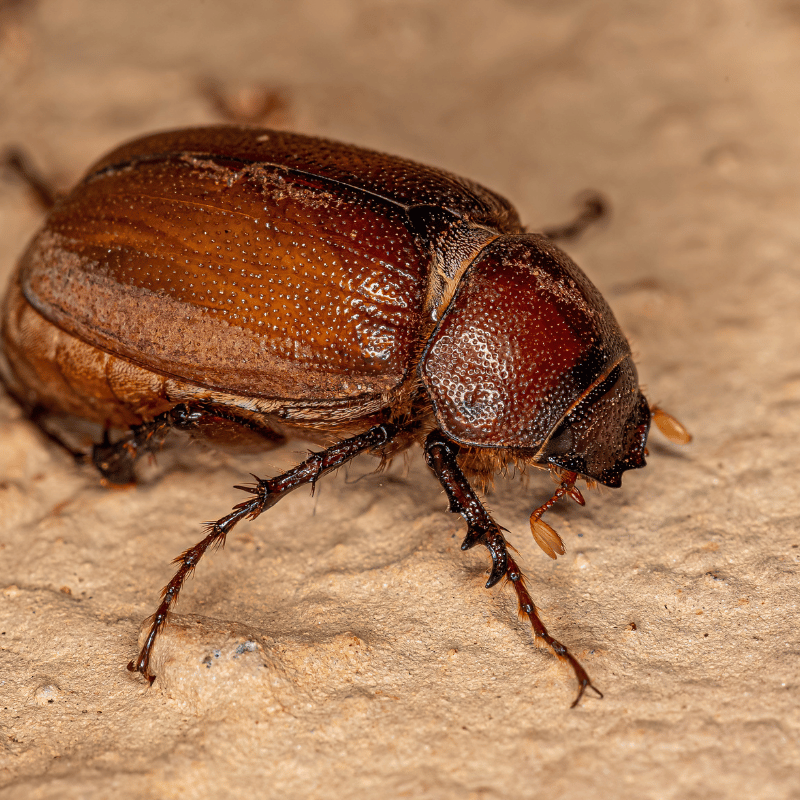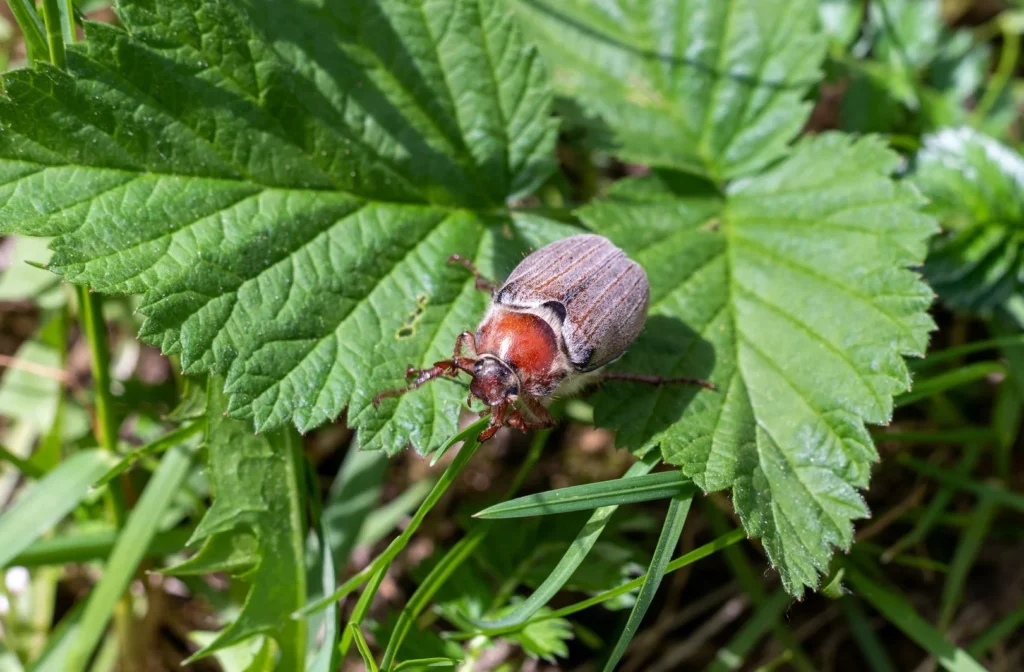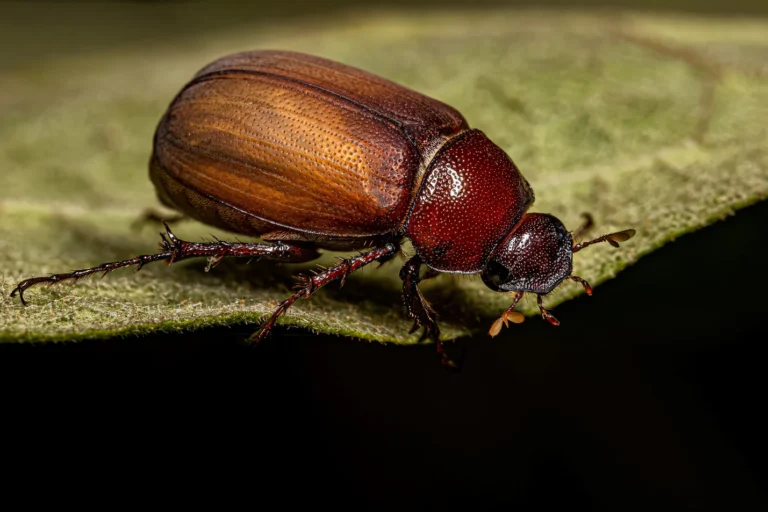June bugs don’t attack; they’re simply drawn to certain things. Their life cycle evolves from larvae to adults, influencing their behavior.
At night, they’re attracted to lights due to their navigation instincts. Your body heat and scents can also attract them, making it seem like they’re following you. It’s crucial to understand they’re not harmful but naturally responding to stimuli.
To prevent this, use less outdoor lighting at night, minimizing exposure. Wearing bug repellent and using scents that deter them are practical measures.
What are the stages in the life cycle of June bugs?

Egg Stage
The life cycle begins when adult female June bugs lay their eggs in the soil during the warm summer months. The female typically chooses a location with suitable conditions, such as loose soil, to deposit her eggs.
Larval Stage (Grub)
Once the eggs hatch, they give rise to larvae, commonly referred to as grubs. These grubs are characterized by a distinct C-shaped body and a creamy-white appearance. During this stage, which can last for several weeks to months, the grubs primarily reside in the soil.
Feeding Habits
Grubs are voracious feeders, consuming organic matter in the soil, including plant roots. While their feeding habits can be destructive to plants, they play a role in nutrient recycling within the ecosystem.
Pupal Stage
As the grubs grow and undergo significant changes, they enter the pupal stage. This stage is marked by the formation of a protective pupal case around the developing insect. Inside the pupal case, the transformation from larva to adult occurs.
Metamorphosis
The pupal stage is a period of metamorphosis, during which the internal and external structures of the insect undergo dramatic changes. This process ultimately leads to the development of the adult June bug.
Adult Stage
The mature adult June bug emerges from the pupal case, completing the life cycle. Adult June bugs are characterized by a hard exoskeleton that provides protection, and they possess wings that allow them to take flight.
Mating and Reproduction
Adult June bugs are primarily active during the evening and are attracted to lights. This behavior is associated with mating, as they use light sources for navigation. After mating, females lay eggs, and the cycle begins anew.
Why Do June Bugs Seem to Follow You?
June bugs seem to follow you at night because they’re naturally attracted to light, especially artificial sources.
Additionally, they might be drawn to your body warmth and certain scents, as they perceive these factors as cues for mating and feeding, making them appear as if they are following you.
Why June Bugs are Drawn to Lights
June bugs are instinctively attracted to light sources, especially during the night. This behavior, known as phototaxis, is linked to their natural instincts for navigation.
Light serves as a guidance system for them, mimicking the moon or other celestial objects. When artificial lights are present, such as outdoor lamps, June bugs may become disoriented, circling the light source.
Simple Insights Into Their Navigation Instincts
June bugs use light for orientation and navigation. Their compound eyes are sensitive to changes in light intensity and direction.
When flying at night, they rely on the moon and stars for guidance. Artificial lights can disrupt this natural navigation system, causing June bugs to fly towards them. This behavior help explain why they may seem to follow you when you are near a light source at night.
How Body Heat Attracts June Bugs?
June bugs are also attracted to warmth, including body heat. When you’re outdoors on a warm evening, the heat radiating from your body may attract them.
This attraction is not aggressive but rather a response to the warmth, as they may perceive it as a potential mate or a suitable environment for feeding and reproduction.
Scents That May Attract Them
June bugs can be drawn to specific scents. While their sense of smell is not as developed as some other insects, certain fragrances may pique their interest. Floral scents, in particular, can attract June bugs.
Using scented lotions, perfumes, or being near blooming flowers might make you more noticeable to them.
How can I prevent June bugs from being attracted to me?

To prevent June bugs from being attracted to you, consider the following measures:
Minimize Outdoor Lighting:
Reduce the use of outdoor lights at night, especially during peak June bug activity. If possible, use motion-activated or yellow bug lights that are less attractive to insects.
Use Bug Repellent
Apply insect repellent on exposed skin to deter June bugs. Look for repellents containing ingredients like DEET or picaridin for effective protection.
Avoid Strong Scents
Be mindful of using strongly scented lotions, perfumes, or hair products, as these scents can attract June bugs. Opt for unscented products when spending time outdoors.
Wear Light-Colored Clothing
June bugs are often attracted to dark colors. Wearing light-colored clothing can make you less noticeable to them.
Stay Indoors During Peak Activity
June bugs are most active during warm evenings. If possible, stay indoors during their peak activity hours, typically around dusk and early night.
Install Screens and Seal Entry Points
Ensure windows and doors have screens to keep June bugs outside. Seal any gaps or cracks in doors and windows to prevent their entry.
Use Natural Deterrents
Consider using natural repellents like citronella candles or essential oils with scents that repel insects. This may help create a less attractive environment for June bugs.
Maintain Yard Hygiene
Keep your outdoor area clean by regularly removing debris, decaying organic matter, and overgrown vegetation. This reduces potential breeding and feeding grounds for June bugs.
Limit Outdoor Activities Near Lights
If possible, avoid prolonged outdoor activities near bright lights, as this can increase the chances of June bugs being attracted to your vicinity.
Consult Pest Control Professionals
If June bug infestations persist, consider consulting pest control professionals for effective and targeted solutions to manage their presence.
FAQ
Why are June bugs so annoying?
June bugs may be perceived as annoying due to their erratic flight patterns and attraction to light, which can lead them to collide with objects and people.
Why do June bugs hit everything?
June bugs are nocturnal and navigate using light. Artificial lights can confuse them, causing them to unintentionally collide with various objects in their attempt to reach the light source.
Why are June bugs so scary?
June bugs might seem scary to some due to their buzzing flight and unexpected appearances. However, they are harmless and do not pose any threat to humans.
What does a June bug turn into?
A June bug undergoes a life cycle that includes stages such as eggs, larvae (grubs), pupae, and finally, it transforms into an adult June bug.
Are June bugs poisonous?
No, June bugs are not poisonous. They do not produce toxins and are harmless to humans. They do not bite or sting.
Why do June bugs scream?
June bugs do not scream. Any noise associated with them is likely a sound produced by their wings or other natural movements. They are not vocal creatures.
Are June bugs scary?
While June bugs might appear intimidating due to their size and flight, they are not harmful or scary. Understanding their behavior can help alleviate fears.
Why do June bugs get stuck in your hair?
June bugs may get caught in hair by accident while flying, especially if they are attracted to light sources. It’s not intentional, and they usually do not cause harm.
Do June bugs fart?
Insects like June bugs release gas as part of their digestive process, but it is not noticeable or perceived as “farting” in the way humans experience it. Their gas production is minimal and not a cause for concern.
Final words
In summary, June bugs aren’t attacking; they’re just doing what comes naturally. Drawn to light, warmth, and scents, they might seem like they’re after you, but they’re harmless. Taking small steps, like using less outdoor light and bug repellent, helps you peacefully share space with them.
By understanding their behaviors, you can enjoy your evenings without feeling bothered. So, when you spot a June bug, remember it’s just exploring the world in its own way. Here’s to coexisting happily!

